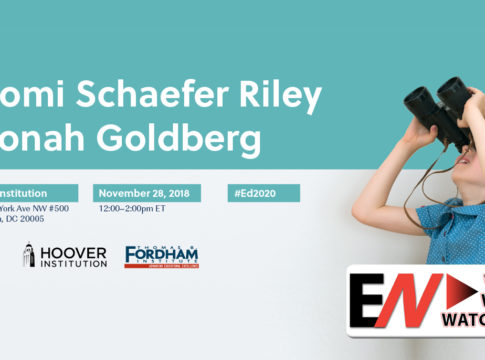
When I agreed to write an appreciation of John Chubb’s work, I had no idea how hard it would be to do him justice. Everyone knew John, who died last year at 61, as the coauthor, with Terry Moe, of “the voucher book.” That’s true but, as I learned, pitifully incomplete. John was too curious, realistic, and open to experience to be pigeonholed.
John was an academic who risked exposure to the real world and a practitioner who used experience to inform theory. He believed that governments and markets had important roles to play but was skeptical of both. He thought it was important to get structures and incentives right but knew that was only the beginning, because success depends on hard work and problem solving in the trenches. Finally, he had a strong commitment to social justice but never let sentiment or wishful thinking cloud his analysis. Here I consider all of the incomplete ways John might be summed up.
Academic
John started his career with a solid doctorate in political science from Minnesota and a plum assistant professor job at Stanford University. He played the academic game right, drawing a book and several articles on the making of U.S. energy policy from his doctoral dissertation. Between 1985 and 1990, he published an astounding four articles in The American Political Science Review, his discipline’s flagship journal.
Policy Wonk
But even while playing the publish-or-perish game, he started to stray from the academic straight and narrow, writing about energy policy and seeking grants to study changes in state-federal relationships in education. Before long, he was on leave from Stanford and in D.C., at the Brookings Institution, a risky move for an untenured professor. Brookings let him take on big problems (national budget priorities, new directions in American politics) and write for nonacademic audiences. At Brookings, John also became skeptical of modern government’s ability to accomplish all the goals that had been set for it. In his book with Paul Peterson, Can the Government Govern?, John argued that to get results in some fields, the government can’t always go it alone and must sometimes use market forces or ally itself with private organizations.
Brookings was also the place where an important collaboration jelled with fellow Minnesota student and Stanford political scientist Terry Moe. Though neither John nor Terry had ever considered becoming an education specialist, each was drawn by the opportunity to analyze a rich new database that allowed comparisons of schools running under differing degrees of regulation. This fit with John’s new interest—and Terry’s long-established one—in exploring mixtures of governmental and market approaches to public problems.
Market Theorist

Their project took seven years of thinking and rethinking. Pulling the results together was a struggle; it clearly wasn’t (as some later charged) something dashed off by advocates who were only looking for a few data points on which to hang a preconceived policy argument. The result, Politics, Markets, and America’s Schools (Brookings 1990), permanently changed the debate over education reform.
If you know about the book secondhand or think it is only about school vouchers, you should read it: you are in for a surprise. The book is subtle and evidence-based, exploring how a combination of autonomy and family choice both allows and motivates school leaders to meet their students’ needs. The book (and, even more sharply, the American Political Science Review article that preceded it) is about how to make schools effective, not simply the virtues of free markets. In fact, as a perceptive review of the book by a prominent left-wing economist admitted, the two authors had constructed a mixed system that headed off possible problems like false information from schools and discrimination in school admissions. Broad attacks in education journals notwithstanding (the book’s advocacy for greater market control was widely criticized), John and Terry had thought the problem through.
John and Terry put everything they had into Politics, Markets and America’s Schools, and 26 years later, it holds up very well. Their earlier work—John’s on how politics biases energy policy and Terry’s on how bureaucracies impede performance by protecting the interests of past legislative majorities—came together. For decades, political scientists had focused on linking political institutions (e.g. election rules) to policy outcomes. Terry and John brought this work down out of the clouds, showing first that politics was driving the performance of schools and second that changes in the loci of power and decision-making could lead to better and fairer results.
Policy Actor
No book on education since the Coleman report in 1966 had received so much attention from popular and academic audiences.
The book’s publication and the reactions to it ended John and Terry’s relative obscurity as junior Brookings fellows and made them figures of public notice and controversy. Though Terry was eager to return to the academic life and soon did, John gave up his position at Stanford, stayed in Washington, and planned more work at Brookings. They collaborated on articles in newspapers and journals elaborating the case for school choice and published a widely read book on school choice in Great Britain.
This was a turning point for John: he was ready to mix it up and wanted to make things happen. Notoriety made him a sought-after speaker for D.C. gatherings and brought him to the attention of George H. W. Bush’s White House. For a while, John considered going into government to advance the idea of “voucherizing” Title I, the federal government’s funding stream for low-income students. John kept working on Brookings projects while exploring that possibility, which ultimately evaporated when the administration decided that the politics were too hard.
Educational Entrepreneur
In 1992, John decided to leave Brookings and join a team being assembled by entrepreneur Chris Whittle to design what came to be called Edison Schools. Edison was to be a privately run, for-profit school provider, but one that ran on government funds generated by hoped-for public school vouchers or contracts with local school districts. Whittle anticipated a strong demand for such schools serving low-income and minority students.
John and other members of Edison’s “design team” set out to develop a schooling model that was effective and attractive to parents. John had left the ivory tower for good. He would be responsible for operating schools, employing and developing educators, and getting results for students and families. As Edison moved forward, John also took on the burden of negotiating agreements with states and localities that wanted to sponsor Edison schools and then showing those entities how they could pay Edison’s costs from available local, state, and federal funds. He quickly became an expert on federal and state funding systems and variations in state education law.
John and Terry’s theories about school autonomy, entrepreneurship, and family choice had laid the groundwork for Edison. As the Edison team grew and gained practical experience, John had to fix problems that arose and figure out what to do when schools fell short of goals for enrollment or student outcomes.
John soon became a formidable expert on a wide range of real-world problems, including recruiting teachers, measuring results, fixing ineffective course plans, motivating students, fixing ineffective schools, and managing relationships with school boards. But he didn’t cast aside his scholarly interests entirely. Though a classically beset operator, John also made time for research and policy analysis.

John leapt at the chance to become a member of the Koret Task Force on K–12 Education at Stanford’s Hoover Institution. Starting in 1999, John wrote a series of articles on the contributions that for-profit school providers could make to public education. In an article in the inaugural issue of Education Next (see “The Private Can Be Public,” forum, Spring 2001), he identified the advantages of for-profits relative to government- and nonprofit-run schools: freedom of action, motivation to serve as many students as possible and to build and maintain brand reputation, and ability to raise investor funds to pay for product development and improvement.
John’s article raised important issues, but his case was ultimately weakened by the experience of Edison and other for-profits, which demonstrated that, despite their advantages, such organizations had two major burdens: dedicated political opposition and investor pressure to build business volume that led to quality problems and drove expansion into extremely risky markets. Philanthropists like Reed Hastings of Netflix (see “Disrupting the Education Monopoly,” features, Spring 2015) also used their money to offset for-profits’ advantages in fundraising and scale. Though few of the resulting nonprofit charter management organizations could beat the best Edison schools in quality, their lower political profile and indulgent sponsors proved important advantages.
After early successes—particularly the creation of some excellent schools—Edison made a lucrative initial stock offering. However, subsequent struggles depressed the stock so severely that a few supporters bought out the investors and took Edison private. John’s hope that his holdings would cover college tuition for his children were dashed. He needed to find other work.
John soon joined an international firm committed to rebuilding schools in Middle Eastern countries. As CEO of Leeds Global Partners, he ran a growing business centered in Abu Dhabi. Before long, however, it became obvious that the required travel between his home in New Jersey and the Middle East was a threat both to his health and to the kind of intimate family life he and his wife Angela wanted above all else. John hoped to return to his roots in policy and research, and to work and live someplace between New York and Washington, D.C.
Return to Policy
Despite operational and business pressures, John never stopped his work as a policy analyst. In 2009, he led the drafting of Learning from No Child Left Behind, a joint statement of the Koret Task Force (of which I was then a member). John argued that the basic principles of No Child Left Behind were valuable and leading to improvements in the education of disadvantaged kids, but that problems in the law’s measurement of school performance and design of remedies required prompt attention. Had these changes been made, the opposition bandwagon that swept No Child Left Behind out of existence in 2015 might not have gotten rolling in the first place.
John returned to Washington and to full-time analysis in 2011. He agreed to rescue Education Sector, a struggling think tank, after the departure of its founder, Democratic policy maven Andy Rotherham. Critics wondered how John, typecast as a neoconservative, would fare as the leader of a center-left think tank. They were surprised by his success, but those who knew John as a fact-driven analyst were not. He created a coherent analytical program for Ed Sector and put it back on the map via his own work analyzing the Common Core State Standards and Secretary of Education Arne Duncan’s No Child Left Behind waivers. He also preserved the Ed Sector brand and key staff by engineering the think tank’s takeover by a much larger research organization, American Institutes for Research, in 2013.
During that same period, John worked again with Terry Moe, producing a coauthored book on the promise of education technology. In Liberating Learning: Technology, Politics, and the Future of American Education, they described innovations in measurement and instructional delivery that could create more individualized and student-centered instruction. As before, they showed how a system built to protect unions and other interest groups fought back against improvements. They also identified financing and human resource challenges that could be met if students, teachers, and money could flow from less- to more-productive forms of schooling. Their policy recommendations, sharpened by experience and examples of opportunities foregone, brought the core ideas of Politics, Markets, and America’s Schools into the twenty-first century.
John also wrote a final, single-authored book, The Best Teachers in the World: Why We Don’t Have Them and How We Could. Observers on the left and right were surprised that John, thought to be a systems guy who cared only about politics and competitive environments, could write so knowledgeably and so passionately about teacher preparation and careers. But to John, a passion for teaching was the natural result of what he had experienced. Autonomous schools in an open, competitive environment are free to seek the teachers they need, but good teachers don’t just emerge; they must be developed. He argued that teaching must and can attract the ablest people, who are not only masters of their craft but also broadly educated and intellectually alive.
Wise and Dedicated Leader
John’s health challenges led him to seek more stable and less physically demanding work.
John’s final job as president of the National Association of Independent Schools (NAIS) reflected his desire to stay engaged in the delivery of education, not just in policy. His appointment by the NAIS board generated controversy among the membership. Skeptics wrote open letters questioning his commitment to quality education and social justice, citing his record as a critic of traditional public schools and proponent of performance-based accountability “against all evidence and reasoning.”
However, true to form, John worked greatly to the benefit of independent schools and the students they served. John’s knowledge, analytic rigor, and openness to facts helped many schools that were struggling to survive. His basic humanity and commitment to the education of the disadvantaged also helped accelerate a growing commitment among independent school leaders to admit and successfully educate larger numbers of minority students.
The wonders of the Internet make it possible to compare blogs and open letters written just after John took the NAIS job and upon his death. The same critics who despaired when John—an academic not a teacher, a critic of public schools, a fellow traveler with economists, and, worst of all, a middle-class white male—was appointed later praised him. He had changed, they said, exhibiting humanity and concern for the disadvantaged. He had overcome past associations and put old friendships—presumably with the likes of Terry Moe and others on the Koret Task Force—at risk. These observers missed the point: John hadn’t changed at all. They had just come to know him.
Conclusion

John’s critics at NAIS were lucky to have observed him so closely and come to understand him in such a short time. Academics, book skimmers, and students who dutifully read snippets assigned in course syllabi will keep trying to reduce John’s thinking to a simple slogan. Some will even claim that the work on teachers, equity, and school quality at the end of his career represented some sort of conversion. In truth, John was too broad and creative to be pigeonholed at any time in his life.
Even those of us who knew and deeply liked John could be surprised by his new ideas and bold reframings. There is nobody else to take John’s place. We will miss him.
Paul T. Hill is founder of the Center on Reinventing Public Education (CRPE) and Research Professor at the University of Washington Bothell.





